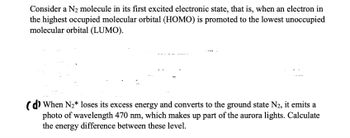Consider a N₂ molecule in its first excited electronic state, that is, when an electron in the highest occupied molecular orbital (HOMO) is promoted to the lowest unoccupied molecular orbital (LUMO). Identify the molecular orbital involved and sketch a diagram to show the transition. Compare the bond order and bond length of N₂* with N₂, where the asterisk denotes the excited molecule. Is N₂* diamagnetic or paramagnetic?
Consider a N₂ molecule in its first excited electronic state, that is, when an electron in the highest occupied molecular orbital (HOMO) is promoted to the lowest unoccupied molecular orbital (LUMO). Identify the molecular orbital involved and sketch a diagram to show the transition. Compare the bond order and bond length of N₂* with N₂, where the asterisk denotes the excited molecule. Is N₂* diamagnetic or paramagnetic?
Chemistry
10th Edition
ISBN:9781305957404
Author:Steven S. Zumdahl, Susan A. Zumdahl, Donald J. DeCoste
Publisher:Steven S. Zumdahl, Susan A. Zumdahl, Donald J. DeCoste
Chapter1: Chemical Foundations
Section: Chapter Questions
Problem 1RQ: Define and explain the differences between the following terms. a. law and theory b. theory and...
Related questions
Question
q3

Transcribed Image Text:Consider a N2 molecule in its first excited electronic state, that is, when an electron in
the highest occupied molecular orbital (HOMO) is promoted to the lowest unoccupied
molecular orbital (LUMO).
Identify the molecular orbital involved and sketch a diagram to show the
transition.
Compare the bond order and bond length of N₂* with N2, where the asterisk
denotes the excited molecule.
Is N₂* diamagnetic or paramagnetic?
When N₂* loses its excess energy and converts to the ground state N2, it emits a
photo of wavelength 470 nm, which makes up part of the aurora lights. Calculate
the energy difference between these level.
Expert Solution
This question has been solved!
Explore an expertly crafted, step-by-step solution for a thorough understanding of key concepts.
This is a popular solution!
Trending now
This is a popular solution!
Step by step
Solved in 3 steps with 3 images

Follow-up Questions
Read through expert solutions to related follow-up questions below.
Follow-up Question
d

Transcribed Image Text:Consider a N2 molecule in its first excited electronic state, that is, when an electron in
the highest occupied molecular orbital (HOMO) is promoted to the lowest unoccupied
molecular orbital (LUMO).
(d) When N₂* loses its excess energy and converts to the ground state N₂, it emits a
photo of wavelength 470 nm, which makes up part of the aurora lights. Calculate
the energy difference between these level.
Solution
Knowledge Booster
Learn more about
Need a deep-dive on the concept behind this application? Look no further. Learn more about this topic, chemistry and related others by exploring similar questions and additional content below.Recommended textbooks for you

Chemistry
Chemistry
ISBN:
9781305957404
Author:
Steven S. Zumdahl, Susan A. Zumdahl, Donald J. DeCoste
Publisher:
Cengage Learning

Chemistry
Chemistry
ISBN:
9781259911156
Author:
Raymond Chang Dr., Jason Overby Professor
Publisher:
McGraw-Hill Education

Principles of Instrumental Analysis
Chemistry
ISBN:
9781305577213
Author:
Douglas A. Skoog, F. James Holler, Stanley R. Crouch
Publisher:
Cengage Learning

Chemistry
Chemistry
ISBN:
9781305957404
Author:
Steven S. Zumdahl, Susan A. Zumdahl, Donald J. DeCoste
Publisher:
Cengage Learning

Chemistry
Chemistry
ISBN:
9781259911156
Author:
Raymond Chang Dr., Jason Overby Professor
Publisher:
McGraw-Hill Education

Principles of Instrumental Analysis
Chemistry
ISBN:
9781305577213
Author:
Douglas A. Skoog, F. James Holler, Stanley R. Crouch
Publisher:
Cengage Learning

Organic Chemistry
Chemistry
ISBN:
9780078021558
Author:
Janice Gorzynski Smith Dr.
Publisher:
McGraw-Hill Education

Chemistry: Principles and Reactions
Chemistry
ISBN:
9781305079373
Author:
William L. Masterton, Cecile N. Hurley
Publisher:
Cengage Learning

Elementary Principles of Chemical Processes, Bind…
Chemistry
ISBN:
9781118431221
Author:
Richard M. Felder, Ronald W. Rousseau, Lisa G. Bullard
Publisher:
WILEY